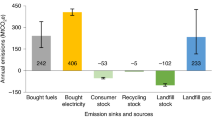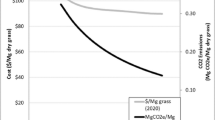Abstract
Worldwide, paper production is a major industry that contributes about 3 percent of Gross World Product. The paper cycle involves a broad range of natural resource and environmental impacts because fiber supply relies on trees, paper manufacturing requires fuel inputs, and paper waste disposal can contribute to emissions of the potent greenhouse gas (GHG), methane (CH4). In some countries, the paper cycle may be seen as a net sink for GHG because of reliance on renewable wood by-products and the maintenance of forest plantations. On a worldwide basis, however, this study demonstrates that the paper cycle is a significant contributor to GHG emissions, adding emissions at least comparable in magnitude to that of Australia each year. The estimated global warming contribution of paper in landfills is estimated to be similar to that of paper manufacturing processes, on a heating-equivalent basis. In some temperate regions, original old-growth forests are still harvested to supply pulpwood, resulting in a significant loss of carbon (C) storage. In theory, the paper cycle holds the promise of achieving zero net emissions if pulpwood production, consumption and disposal are carefully managed. In practice, even stabilization of emissions at current levels would be challenging and entail changes comparable to a 20 percent reduction in CH4 generation from landfilled paper, and a 2.5 percent annual increase in plantation establishment would be needed to offset the projected increase in emissions from paper manufacturing.
Similar content being viewed by others
References
Barrett-Brown, L.: 1999, Natural Resources Defense Council. Washington DC. Personal communication.
Bass, S.: 1996, International Institute for Environment and Development, London, UK. Personal communication.
Bingemer, H.G. and Crutzen, P.: 1987, The production of methane from solid wastes, Journal of Geophysical Research 92 (D2), 2181–2187.
Cooper, D. and Zetterbreg, L.: 1994, Swedish Forest Industry's Emissions and Uptake of Greenhouse Gases: An Assessment of the Forestry Industry's Contribution to the Geenhouse Effect, Swedish Environmental Research Institute, Gothenburg.
Ellis, J.: 1996, International Energy Agency, Organisation for Economic Cooperation and Development, Paris. Personal Communication.
FAO: 1993, Tropical Forest Assessment, Food and Agriculture Organization, Rome, Italy.
FAO: 1995a, Forest Products Forecasts to 2010, Unpublished working papers and data tables, Food and Agriculture Organization, Rome.
FAO: 1995b, Recovered Paper Data, 1992- 1995, Food and Agricultural Organization, Rome, Italy.
Harmon, M.E., Ferrell, W.K. and Franklin, J.F.: 1990, Effects on carbon storage of conversion of old-growth forests to young forests, Science 247, 699–702.
Hartman, D.A., Atkinson, W.A., Bryant, B.S. and Woodfin, R.O.: 1976, Conversion Factors the Pacific Northwest Forest Industry, Institute of Forest Resources, College of Forest Resources, University of Washington, Seattle.
Hershkowitz, A.: 1997, Too Good to Throw Away: Recycling's Proven Record, Natural Resources Defense Council, New York, New York.
IEA: 1993, Energy Statistics of OECD Countries: 1990- 1991, IEA/OECD. Paris.
IEA/OECD: 1991, Energy Efficiency and the Environment, IEA/OECD, Paris.
IIED: 1995, Paper Farming: The Role of Plantations in the Sustainable Paper Cycle, IIED.
IIED: 1996, Towards a Sustainable Paper Cycle, Prepared for the World Business Council for Sustainable Development by the International Institute for Enviornment and Development, London.
IISI: 1992, In: World Energy Council 1995, Energy Efficiency Improvement Utilising High Technology, World Energy Council, London.
INC: 1994, Matters Relating to Commitments: First Review of Information Communicated by Each Party Included in Annex I to the Convention, A/AC.2347/81.7, United Nations General Assembly, New York.
INC: 1995, Matters Relating to Commitments. First Review of Information Communicated by Each Party, FCCC/1995/Inf. 4, Berlin.
IPCC: 1994, Report on Radiative Forcing of Climate, Intergovernmental Panel on Climate Change, Geneva.
IPCC/OECD: 1994, Greenhouse Gas Inventory Reference Manual, IPCC Draft Guidelines for National Greenhouse Gas Inventories, Paris.
Kurz, W.A.: 1998, ESSA Technologies Ltd., Vancouver, Canada. Personal communication.
OECD: 1993, OECD Environmental Data Compendium 1993, Organisation for Economic Cooperation and Development, Paris.
OECD: 1995, OECD Environmental Data Compendium 1995, Organisation for Economic Cooperation and Development, Paris.
OECD/IEA: 1993, World Energy Balances, OECD/IEA, Paris.
Pingoud, K., Savolainen, I., and Seppala, H.: 1996, Greenhouse impact of the Finnish forest sector including forest products and waste management, Ambio 25(5), 318–326.
PIRA: 1996, Life Cycle Assessment Study to Illustrate the Environmental Burdens of Transportation with the Paper Cycle, Prepared by Nicholas Turner for the International Institute for Environment and Development, January.
PPI: 1995, International Fact and Price Book, Pulp and Paper International, Miller Freeman, Brussels, Belgium.
Price, D.T., Halliwell, D.H., Apps, M.J., Kurz, W.A. and Curry. S.R.: 1997, Comprehensive assessment of carbon stocks and fluxes in a boreal-cordilleran forest management unit, Canadian Journal of Forestry Research 27, 2005–2016.
Row, C.: 1995, Full-Cycle Carbon Capture from International Paper's Tropical Reforestation Project, An Analysis for the International Paper Company, Row Associates, Edgewood, MD, USA.
Schlesinger, W.H.: 1977, Carbon balance in terrestrial detritus, Annual Review of Ecology and Systematics 8, 51–81.
Sedjo, R., A., and Lyon, K.S.: 1996, A Global Pulpwood Supply Model and Some Implications, Substudy No. 2 for the International Institute for Environment and Development. Resources for the Future, Washington DC.
Subak, S., Craighill, A., Guthrie, M. and Kelly, M.: 1996, The Paper Industry and Global Warming, Sub-study No. 20 for the International Institute for Environment and Development.
Subak, S., Raskin, P. and Von Hippel, D.: 1993, National greenhouse gas emissions: current anthropogenic sources and sinks, Climatic Change 25, 15–58.
Trexler, M.C.: 1991, Minding the Carbon Store: Weighing U.S. Forestry Strategies to Slow Global Warming, World Resources Institute, Washington, DC.
United Nations: 1992, International Trade Statistics Yearbook, Trade by Commodity, United Nations, New York.
UNECE and FAO: 1992, The Forest Resources of the Temperate Zones: Main Findings of the UNECE/ FAO 1990 Forest Resource Assessment, United Nations Economic Commission for Europe and Food and Agriculture Organization of the United Nations, New York.
UNFCCC: 1996, National Communications. www.unfccc.de/
UNFCCC: 1998, Review of the Implementation of Commitments and of Other Provisions of the Convention, Buenos Aires, 2- 15 November 1998, FCCC/CP/1998/INF.9.
U.S. EPA: 1991, Analysis of Factors Affecting Methane Gas Recovery from Six Landfills, EPA-600/R-92-037. Air and Energy Engineering Research Laboratory, Research Triangle Park, North Carolina.
U.S. EPA: 1993, Anthropogenic Methane Emissions in the United States: Estimates for 1990, Report to the Congress. Global Change Division, Office of Air and Radiation, Washington, DC.
Von Hippel, D., Raskin, P., Subak, S., and Stavisky, D.: 1993, Estimating greenhouse gas emissions from energy: two approaches compared, Energy Policy (March), 691–702.
Watson, R.T., Meira Filho, L.G., Sanhueza, E. and Janestos, A.: 1992, Sources and Sinks, Climate Change 1992: The Supplementary Report, Intergovernmental Panel on Climate Change, Cambridge University Press, Cambridge.
Williams, A. (ed.): 1994, Methane Emissions, Watt Committee Report Number 28, Watt Committee of Energy, London.
WRI: 1995, Fiber Sourcing Analysis for the Global Pulp and Paper Industry, Final Report to IIED. Wood Resources International, Reston Viriginia, U.S.A., June.
Author information
Authors and Affiliations
Rights and permissions
About this article
Cite this article
Subak, S., Craighill, A. The contribution of the paper cycle to global warming. Mitigation and Adaptation Strategies for Global Change 4, 113–136 (1999). https://doi.org/10.1023/A:1009683311366
Issue Date:
DOI: https://doi.org/10.1023/A:1009683311366




